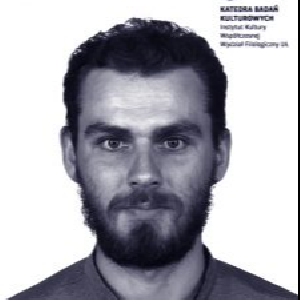Pracownicy

dr
Łukasz Biskupski
Profile naukowe, dydaktyczne i społecznościowe
Czym się zajmuję - opis stanowiska
adiunkt
Pracownik naukowo-dydaktyczny.
Biogram
Cultural historian and film studies scholar. Associate professor at the Department of Cultural Research at the University of Łódź, specializing in cultural history of cinema, mass culture, and urban entertainment, with particular emphasis on early cinema in Poland and cultural modernization processes. His research integrates cultural history, film studies, and materialist cultural analysis. He received his MA in Cultural Studies from the University of Łódź and completed his doctoral studies at SWPS University in Warsaw with a distinguished dissertation on street art and visual culture, which was awarded the Inka Brodzka-Wald Prize by the Polish Academy of Sciences. After his doctorate, he conducted post-doctoral research at the University of Gdańsk as part of a National Science Centre FUGA grant.
Before focusing fully on academic work, he served as Academic Program Curator at the Museum of Art in Łódź, Curator at the National Center for Film Culture, and Program Director of the Regional Congress of Culture in Łódź.
Dr. Biskupski is a co-founder and former vice-chairman of the Urban Initiatives Association "Topografie" in Łódź. He was part of the team developing programs at the Municipal Culture Point Prexer-UŁ, a cultural center operating under the patronage of the University of Łódź. He co-authored the concept for Miastograf.pl digital archive.
<h1>Research Interests</h1>- Cultural history of cinema and entertainment
- History of popula culture
- Urban cultural practices and modernization
- Street art and visual culture
- Film industry history
- Cultural studies methodology and history
<h1>Academic Career</h1>
- University of Łódź (2020-present)
- Post-doctoral Researcher, Department of Cultural Studies, University of Gdańsk (2016-2019), National Science Centre FUGA Grant
- Department of Humanities, SWPS University of Social Sciences and Humanities, Warsaw (2013-2016)
<h1>Books</h1>
Prosto z ulicy: sztuki wizualne w dobie mediów społecznościowych i kultury uczestnictwa - street art. Warszawa: Bęc Zmiana - SWPS, 2017
Visual Arts in the Age of Social Media and Participatory Culture - Street Art
Drawing from street art as a case study, this book examines transformations in visual arts in an era dominated by social media's influence on artistic and market hierarchies. The internet's evolution has fundamentally restructured media content production, previously controlled by major institutional players. The emergence of new cultural distribution channels, particularly blogs and social media, has enabled circumvention of traditional cultural gatekeepers. This shift has generated novel value hierarchies, networks of influence, and intermediary roles, while accelerating professional development pathways. Termed "participatory culture" by media scholars, this phenomenon extends beyond digital spaces to reshape various spheres of social reality, including visual arts. Street art practices exemplify this transformation of power relations within visual arts. Employing the sociological concept of 'circuit,' the author demonstrates how street art represents a new 'popular' artistic circuit that epitomizes the dynamics of participatory culture.
Review:
Kazimierska-Jerzyk, Wioletta. “Wartości Street Artu.” "Kultura Współczesna" Nr 3/2019, Miasta-Utopie, 2019. doi:10.26112/kw.2019.106.15.
Papierowi bandyci: wypisy z polskojęzycznych powieści obiegu brukowego do 1939 roku. Łódź: Officyna, 2017.
Kinofilia zaangażowana: Stowarzyszenie Miłośników Filmu Artystycznego "Start" i upowszechnianie kultury filmowej w latach 30. XX w. Łódź: Officyna, 2017.
Review:
Talarczyk, M. (2018) „ Restart Stowarzyszenia Miłośników Filmu Artystycznego”, Kwartalnik Filmowy , (103), s. 237–241. doi: 10.36744/kf.1931.
Miasto Atrakcji. Narodziny kultury masowej na przełomie XIX i XX wieku. Kino w systemie rozrywkowym Łodzi. Warszawa: Narodowe Centrum Kultury, 2013.
"City of Attractions" examines the transformation of popular culture and emergence of cinema in late 19th/early 20th century Łódź—the largest industrial center in the Polish provinces of the Russian Empire.
The study traces cinema's "double birth" within the city's entertainment system. The cinematograph emerged in the 1890s as a novel technology within the established culture of attractions, alongside curiosity shows and variety theaters. After 1907, cinema evolved into a distinct entertainment sector, developing dedicated venues and cultivating a regular audience engaged in what contemporary press dubbed "cinemadness."
This history of a "city of attractions" illuminates how mass commercial entertainment shaped modern consumer society on Europe's periphery. As primary sites of urban consumption, cinematograph theaters offered accessible cultural products that embodied modernity itself. The practice of "cinemadness" enabled participation in an imagined cosmopolitan lifestyle, while films served as practical guides to modern living. Cinema's inherently cosmopolitan nature fostered a unified, homogeneous audience whose size reflected society's broader capacity for consumer participation—thus exemplifying the distinctive patterns of peripheral modernization.
Download: OPEN - the Repository of Open Scientific Publications
Review:
Kołos, Sylwia. Łukasz Biskupski, Miasto Atrakcji. Narodziny kultury masowej na przełomie XIX i XX wieku. Kino w systemie rozrywkowym Łodzi, Narodowe Centrum Kultury, Warszawa 2013, ss. 320. Klio - Czasopismo Poświęcone Dziejom Polski i Powszechnym [online]. 6 czerwiec 2014, T. 28, nr 1, s. 229–232. DOI 10.12775/KLIO.2014.013.
Zaremba, Łukasz. “Recenzja Książki ‘Miasto Atrakcji’ Łukasza Biskupskiego.” "Kultura Współczesna" 2014, Nr 1, 2014.
Research Projects
- "History of the Sfinks Company Against the Background of Film Industry Organization in the Second Polish Republic" (2016-2019) - Principal Investigator, Post-doctoral National Science Centre FUGA Grant (2016/20/S/HS2/00121)
- "History of Popular Culture in Poland in the First Half of the 20th Century from a Transmedial Perspective" (2013-2016) - Main Researcher, National Science Centre SONATA BIS Grant (2012/07/E/HS2/03878)
- "Popular Culture and Early Cinema in Polish Territories Under Russian Rule 1890-1914" (2013-2015) - Principal Investigator, National Programme for the Development of Humanities Grant (21H12020681)
Conference Organization
- Chairman of Organizing Committee, "History of Popular Culture in Poland until 1939," SWPS University (2015)
- Member of Organizing Committee, "Archives of/for the Future" - European Network for Cinema and Media Studies (NECS) Congress, University of Łódź (2014)
Awards and Recognition
- Inka Brodzka-Wald Award for best doctoral dissertation, Polish Academy of Sciences (2016)
Dyżury
adiunkt
DYŻURY CYKLICZNECZWARTEK
12:00 - 13:00
Pomorska 171/173 pokój: 3.07 90-236 Łódź
Kontakt
adiunkt
ul. Narutowicza 68, 90-136 Łódź
NIP: 724 000 32 43
KONTAKT
